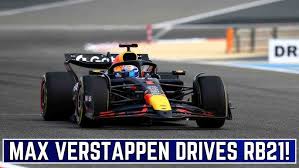
Red Bull’s RB21: A Car Only Max Verstappen Can Tame
The Red Bull Racing team has enjoyed immense success in recent years, largely thanks to the brilliance of Max Verstappen. However, the RB21, the car that propelled the team to victory in 2021, has been the subject of harsh criticism within Formula 1 circles. Many have argued
that the RB21 is a car that only Verstappen can truly handle, raising concerns about its consistency and versatility when it comes to other drivers in the team or across different race conditions.
While the RB21 undoubtedly boasts raw speed and technical sophistication, its handling characteristics are often described as unpredictable, especially in challenging weather conditions. Verstappen, with his remarkable skill and deep understanding of the car, has been able to extract its maximum
potential, particularly when conditions are tricky. His ability to manage the car’s quirks, especially when the rear end steps out or the balance shifts unpredictably, has been a standout feature of his driving. However, when compared to other drivers who have taken a seat in the Red Bull, such as Sergio Perez, it becomes evident that the car’s performance can be less forgiving.
Perez, who joined the team in 2021, has struggled at times to match Verstappen’s pace, especially in races where tire management or track evolution becomes crucial. While Perez has had flashes of brilliance, such as his win in Azerbaijan, he has often found himself battling the car’s peculiarities, something Verstappen
has mastered over the years. The criticism here isn’t necessarily about Perez’s ability as a driver, but rather about the car’s design being inherently suited to Verstappen’s unique driving style, making it difficult for others to fully harness its potential.
The RB21’s rear instability is often highlighted as a factor that makes it tricky for drivers who aren’t as attuned to its characteristics as Verstappen. This issue, combined with the car’s highly sensitive aerodynamics, means that it demands a level of finesse and adaptability that only a few elite drivers possess. Verstappen’s
intimate knowledge of the car’s behavior, combined with his aggressive yet controlled driving style, allows him to extract performance in ways that others simply cannot replicate.
While the RB21’s design might be tailored to Verstappen’s skill set, it raises an important question about Red Bull’s long-term strategy: Is it sustainable to rely on a single driver to extract the full potential of the car? For a team
with such a prestigious pedigree and championship aspirations, it’s concerning that they have created a car that seems almost exclusively tailored to one individual.
This issue could pose problems not only for Red Bull’s success in the coming years but also for their driver lineup. Formula 1 is a team sport, and no matter how talented a driver is, the team’s success relies on the collective performance of both drivers. Having one driver
consistently outperforming the other raises concerns about the team’s ability to challenge for championships across the board. In an era where constructors’ titles are as important as drivers’ titles, Red Bull’s emphasis on Verstappen could ultimately undermine their pursuit of a well-rounded and competitive lineup.
From a team dynamics perspective, the RB21’s design challenges create an uneven playing field for the drivers. While Verstappen shines, Perez and other potential candidates may find it difficult to shine under the same conditions. This disparity could potentially foster a sense of dissatisfaction within the team, especially if
they continue to struggle in comparison to Verstappen. The perception that the car is built for one driver could lead to long-term tensions within the team and might hinder the team’s ability to attract or retain top talent.
Moreover, Formula 1 is evolving, with car designs continually shifting in response to new regulations and technological advancements. It’s unclear whether Red Bull’s approach will continue to yield results as the sport progresses. While Verstappen’s exceptional talent might continue to propel the team forward in the
short term, relying so heavily on one driver could limit their ability to adapt in the future. Other teams, such as Mercedes and Ferrari, are always looking for ways to counter Red Bull’s dominance, and if those teams create cars that are more versatile and adaptable, Red Bull’s strategy may face challenges.
In conclusion, the RB21’s unique handling characteristics and the dependence on Max Verstappen to maximize its performance raise concerns for Red Bull’s long-term strategy. While Verstappen’s ability to master the car is indisputable, the broader question remains: Can
Red Bull afford to rely so heavily on one driver, or will they need to evolve their approach to remain competitive in the ever-changing world of Formula 1? Only time will tell whether the RB21’s success is sustainable beyond the dominance of Max Verstappen.
Leave a Reply